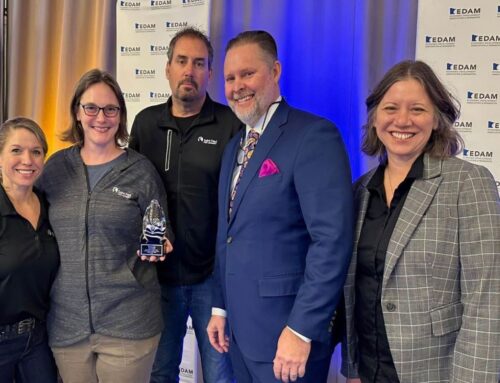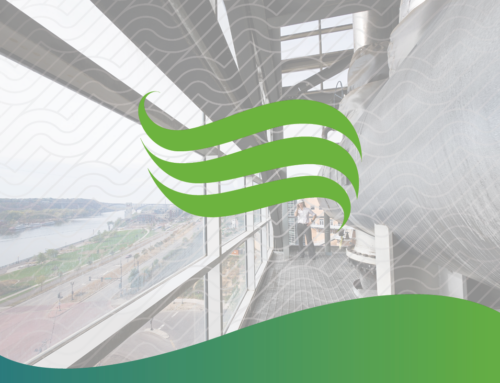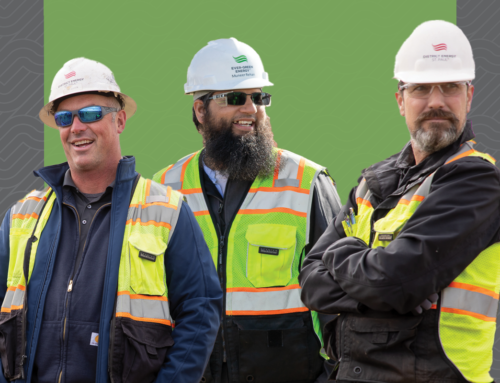
Technology Spotlight: Geoexchange Energy Systems
January 7, 2020 by Ever-Green Energy
Ever-Green Energy has been adapting its approach to energy and utility system planning to stay at the forefront of important trends in technology, consumer demand, and the need to reduce greenhouse gas emissions and create more sustainable systems. This has led to rethinking how we provide heating and cooling to buildings and communities.
Of the technologies that have emerged as competitive, geoexchange solutions have proven to be one of the most technically and economically feasible alternatives to traditional fossil fuel systems.
Ever-Green uses geoexchange as an umbrella term for sources that can provide a low-grade heat source and heat sink for the purposes of heating and cooling buildings.
Although geothermal wells with ground-source heat pumps are the most widely known application, our team is developing projects using bay water exchange and aquifer thermal energy storage that are slated for potential start up in 2020 and 2021.
To increase awareness of these applications and their potential benefits, we are using this edition of our blog to outline how each one functions and where it is already in use or being considered. It is important to note that building efficiency is a common factor in evaluating the feasibility of geoexchange projects. High-efficiency buildings reduce overall thermal energy consumption, enabling more effective use of the electricity that is used to adjust the water loop to the optimal temperature. We discussed the challenges and opportunities with beneficial electrification in our blog, Beneficial Electrification: Smart System Transformation.
Geothermal
Geothermal is broadly defined as the capture of thermal energy from the internal heat of the earth. Historically, geothermal was most commonly deployed in areas with large reservoirs of heat, particularly near volcanoes or other geologic formations with higher concentrations of available heat. The largest systems of this type produce heat intense enough to generate power, accounting for 3.7 gigawatts in the United States according to the US Department of Energy. Heating and electricity production from geothermal account for 2% of the overall energy portfolio in the U.S., according to the International Energy Agency.

In recent years, geothermal for heating and cooling of buildings and district energy systems has become more common as technologies advance and more emphasis has been placed on decarbonizing thermal energy sources.
Geothermal systems utilize vertical closed-loop wells that are drilled into the earth, or horizontal wells, to provide heat exchange with the ground. Geothermal well fields are typically closed-loop, meaning that the circulating fluid is not directly in contact with the ground or groundwater aquifers to prevent contamination. Specific well field design varies by topography, geology, and climate. Once in place, the wells allow heat to both be drawn from the earth during the winter and rejected from buildings back into the earth during the summer. Ground temperatures vary by region and systems must be designed to effectively work with the available thermal capacity of the earth. These systems are usually designed to allow rejected heat from air conditioning during the summer months to be stored and reused during the heating season.
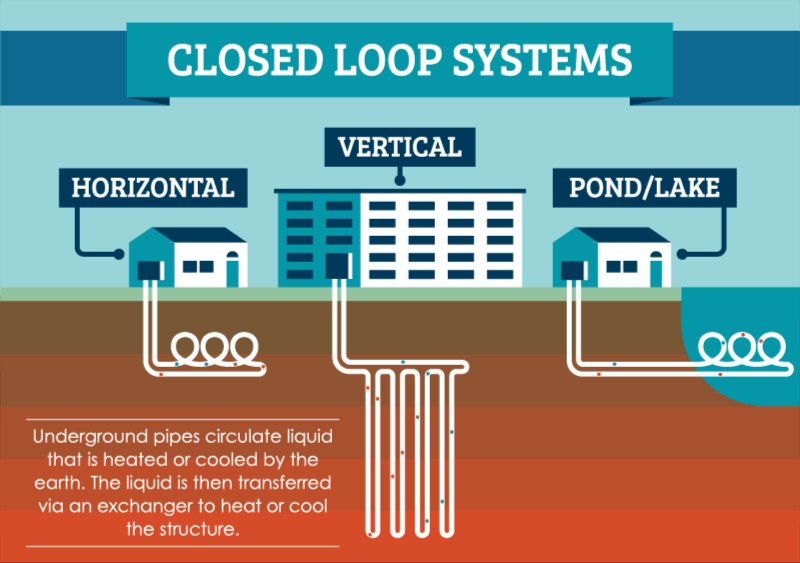
Several of Ever-Green’s master planning clients have considered geothermal as part of their energy portfolio, including Coralville, Iowa, and Oberlin College in Ohio. If Oberlin College moves forward with the geothermal option, it will result in an 89% greenhouse gas reduction from their 2007 baseline upon project completion. Our sustainability and outreach partner, Carleton College, has installed 94 horizontal geothermal wells and 210 vertical geothermal wells on their campus. The college partnered with MEP Associates for the design and installation of the geothermal system. They were the first college campus in Minnesota to have a geothermal-based district energy system, which was enabled by first transitioning the campus district energy system from steam to hot water.
Aquifer Thermal Energy Storage
Aquifer thermal energy storage (ATES) is well suited for application in low-temperature district energy systems, and the technology is well established in Northern Europe, where thousands of ATES projects have been commissioned and are operational.
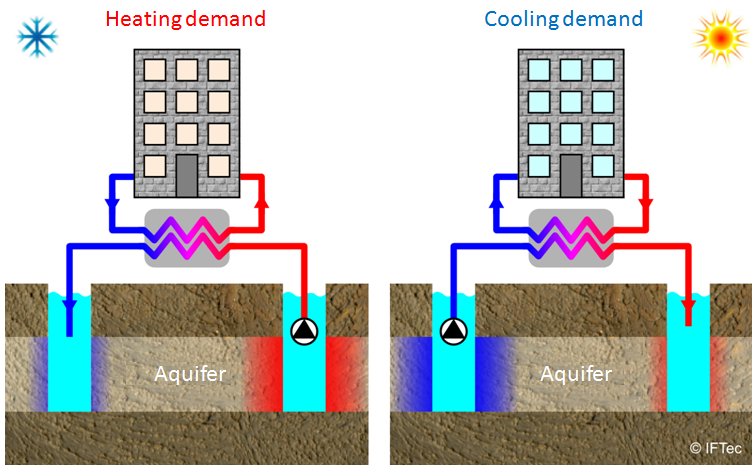
Aquifer Thermal Energy Storage – Heating in Winter and Cooling in Summer
Similar to geothermal technology, ATES depends on below ground conditions and storage potential for the energy rejected from the buildings. The major difference is that these systems rely on wells that interface with the water in an aquifer. ATES systems draw heat from an aquifer in the winter to heat buildings with geothermal heat pumps, using an open-loop well system and closed-loop distribution system that is isolated from the well system by a heat exchanger. The cooled aquifer water is then utilized in the summer to cool the same buildings, making it an ideal and cost-competitive year-round solution. Aquifer water only interfaces with a heat exchanger to remove or reject heat, and it is not modified or depleted. The district system and the buildings each use a closed-loop for distributing and exchanging energy. ATES systems rely on slow-moving aquifer conditions to retain seasonal storage for the water removed and rejected into each area of wells. Water moving too swiftly would forego the storage potential of the system.

The Ever-Green team conducted ATES analyses for both the Ford and Hillcrest redevelopment sites in Saint Paul, Minnesota, in partnership with Underground Energy, one of the foremost experts on geothermal energy storage technology, including ATES. Both sites were pursuing higher efficiency and lower carbon design standards that could be more readily met by incorporating ATES with district energy. Ever-Green is also closely involved in the Towerside Innovation District in Minneapolis. This district is a collaborative development effort with a commitment to sustainability, which has led to the examination of ATES integration for a series of buildings intended to begin construction in late 2020. Towerside’s district energy system will benefit from a 40% greenhouse gas reduction compared to the business as usual base case, based on the 2020 electric grid profile. The reductions will be even more substantial as the grid decarbonizes, reaching 60% in 2030 and 100% in 2050.
Wastewater Exchange
Although wastewater exchange does not rely on geothermal energy, it is included in the category of geoexchange because it shares in the base principles of heat extraction, heat rejection, scalability and efficiency gains from district energy integration, and beneficial electrification and decarbonization potential. In a wastewater exchange system, thermal energy is extracted or rejected from wastewater utilizing a heat pump, and the capacity of the system is proportional to the flow rate in the wastewater line.
Ever-Green has examined this approach for several district energy systems. Although there are not any current plans to proceed with implementation for this approach, there are existing and planned systems that serve as successful examples. The False Creek Neighborhood in Vancouver, Canada, was the first utility in North America to decarbonize a system using wastewater and district energy infrastructure. See the International District Energy Association’s 2018 feature on Vancouver’s system, Metro Vancouver’s vibrant district energy market.
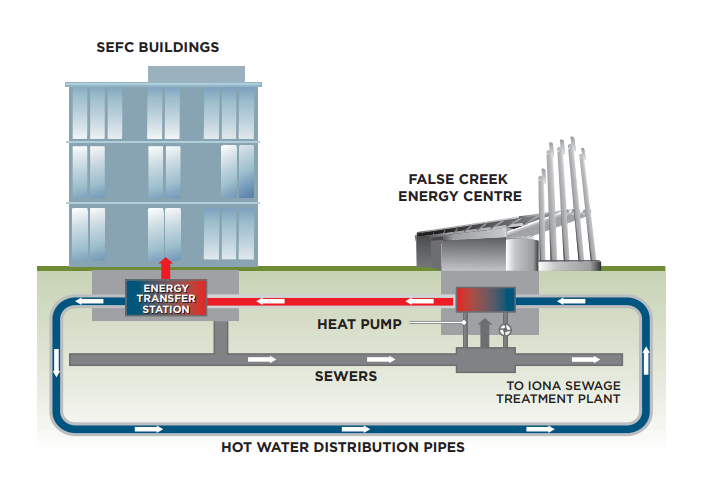
The False Creek Energy Centre, integrated with a sewage pumping station, recovers heat from untreated urban wastewater, a renewable energy source.
Today, this system serves 32 buildings, and the wastewater exchange accounts for 70% of the annual energy demand of the neighborhood and reduces greenhouse gas emissions by 50%.
In Denver, the National Western Center is a 250-acre campus redevelopment in the North Denver Cornerstone Collaborative district. The project is a public-private partnership that is part of a nationwide net zero development cohort, led by the National Renewable Energy Laboratory. The potential is significant, with the heat available being more than twice the capacity required to supply the entire campus, according to the partnership. Enwave is leading the technical development of this system.
Bay Water Exchange
A groundbreaking project beginning construction in 2020 is the Mission Rock development in San Francisco. Mission Rock is a key gateway development and one of the most prominent undeveloped sites in the Mission Bay neighborhood of San Francisco. The sustainability vision for Mission Rock is for 100% of the energy use to come from renewable sources and for the buildings to be highly efficient. Additional commitments include zero use of potable water for non-potable purposes. To achieve this vision, the San Francisco Giants are collaborating with Tishman Speyer, the City of San Francisco, the San Francisco Port Commission, the San Francisco Public Utilities Commission, and Ever-Green to develop and implement options for sustainable, resilient, reliable, and cost-effective energy and water solutions.

Aerial rendering of Mission Rock development
Several geoexchange and renewable energy options were considered for this development. The proximity of the project site to the San Francisco Bay provides the opportunity to utilize bay water for both cooling and heating of buildings at Mission Rock.
The bay water temperature will typically range from 50°F-62°F throughout the year. At these temperatures, bay water can be used as condenser water for heat rejection from chillers and as a source of heat for water-source heat pumps that generate hot water for the project. This approach enables the site to be all-electric, which will lead to a 100% reduction in carbon emissions when the site is fully built out by coupling the bay water exchange with 100% hydro-based renewable electricity supplied to the site. By replacing conventional cooling towers, the bay water exchange system also conserves millions of gallons of water per year.
See Ever-Green’s project profile on the Mission Rock project.
Energy markets will continue to demand evolving technologies that can reduce carbon and provide reliable and affordable energy to customers. Ever-Green carefully examines the unique characteristics of any project, its local resources, the goals of users, and the policies and technical constraints of their development. We look forward to seeing the continued opportunities for geoexchange as a low-carbon solution that can be included in integrated and resilient systems.

